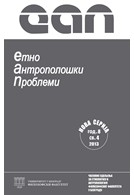Životinje između Prirode i Kulture: priča o arheozoologiji
Animals between Nature and Culture: The Story of Archaeozoology
Author(s): Ivana ŽivaljevićSubject(s): Anthropology, Archaeology, Social Theory
Published by: Филозофски факултет, Универзитет у Београду
Keywords: archaeozoology; dichotomy; nature; culture; animals; animal remains;
Summary/Abstract: The paper aims to tell the story of archaeozoology and utilize it to point out changes in the perception of nature and culture, the perception of animals as organisms that belong entirely to the domain of nature (unlike people who ‘build’ culture onto their nature), as well as display how these perceptions shaped the discipline of archaeozoology and influenced its position within archaeology. Animal remains, almost as a rule, represent some of the most common findings at archaeological sites; however, the attention which has been given to them in archaeological analysis and interpretation was largely dependent on the dominant paradigms in science. With the appearance of the ‘new’ or processual paradigm in archaeology and the concurrent development of archaeozoology, findings like these became the object of study and an important ‘key’ for understanding questions of sustenance, economy and strategies of survival in the past. The strict divide between the natural sciences and humanities (which is a consequence of the wider modernist narrative about the dichotomy of nature and culture), meant that only specialized experts could study animal remains, and that animal remains should be viewed, studied and published on separately from studies on architecture, sculptures and figurines, tools and other artifacts. Thus, archaeozoological reports long represented merely a kind of ‘addition’ to archaeological publications and rarely figured significantly in interpretations. With the paradigm shift brought on by post-processual archaeology, the research focus shifted from economic and functionalist explanations of social phenomena to the study of the influence of culture on shaping human behavior and values. Social theories of cultural constructivism indicate that concepts of ‘humanity’ and ‘animality’ are culturally shaped and a product of discourse, but they often ignore osteological analyses of human and animal remains in the process. Even though at first glance it may seem that constructivist studies and the positivist scientific method on which osteology is based are mutually exclusive in contemporary archaeology, their integration can provide a more detailed picture of how animals shape the way in which humans experience the world, of meanings ascribed to animals, as well as of the very nature of boundaries between people and animals in different cultural contexts.
Journal: Етноантрополошки проблеми
- Issue Year: 8/2013
- Issue No: 4
- Page Range: 1137-1163
- Page Count: 27
- Language: Serbian

